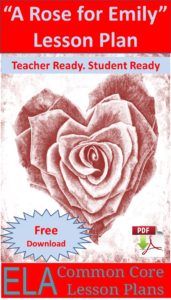When I think of my first teaching job, all that I seem to remember is dust—the brown, crumbly dust of late summer—arid, sterile dust that gets into the eyes and makes them water, gets into the throat and between the toes. I don’t know why I should remember only the dust. Surely there must have been well thought out lesson plans aligned to ELA Standards and paved courtyards under leafy shade trees somewhere in the school. In fact, I do recall “Marigolds” short story lesson plans. Here’s a great one on setting and plot I remember.
“Marigolds” Plot and Setting Lesson Plan
Now that you’ve downloaded the “Marigolds” lesson plan on plot and setting, all you have to do is print, copy, and continue online shopping. Or you could upload it and post it online for students to enjoy.
Or you could keep on reading.
“Marigolds” Summary
An adult looks back at her childhood and remembers two things: dust and Miss Lottie’s marigolds. Both would have an impact on Lizbeth’s life—the dust reminds her of poverty and Miss Lottie’s marigolds remind her of the destruction she’s caused.
Lizbeth and the neighborhood kids, including her brother, are bored. And life sucks. It sucked before the Great Depression and sucks even more now. Anyhow, the kids are bored and they head over to Miss Lottie’s yard to throw pebbles at her and her marigolds. Miss Lottie’s son eventually chases them away.
When Lizbeth gets home, she overhears a conversation between her mother and father. Her dad is crying because he can’t find work and feels like a failure. This is the last straw. Lizbeth gets up early and destroys Miss Lottie’s marigolds. She looks up and sees Miss Lottie and recognizes her for who she is—a human.
She feels bad.
“Marigolds” Analysis
- Conflict. This really isn’t a conflict between the narrator and Miss Lottie, is it? Granted, she does defeat Miss Lottie and her marigolds, but she’s battling societal conditions. This is more of an individual vs. society conflict. There’s also an internal conflict as an adult narrator tries to makes sense of her senseless act.
- Character Analysis. The characters in the story are human. Humans do things for a reason, albeit not always logical ones.
- Plot. The entire story is a flashback and is mostly told in chronological order.
- Setting. The story’s setting—the Great Depression—in an African-American neighborhood is critical to other story elements.
- Narrative Writing. I wonder what Lottie’s thinking during this whole episode?
- Flowers. Looks like Wordsworth’s view of daffodils differs greatly from the narrator’s opinion of her neighbor’s marigolds.
ELA Standards for “Marigolds” Plot and Setting Lesson Plan

Here’s a different kind of flower for a story that’s a little creepy. And here’s a lesson plan for it.
Be sure to download the lesson plan. Here are the standards I usually write on the board when I teach it. Feel free to tweak.
- RL.9-10.1 – Cite strong and thorough textual evidence to support analysis of what the text says explicitly as well as inferences drawn from the text.
- RL.9-10.2 Determine a theme or central idea of a text and analyze in detail its development over the course of the text, including how it emerges and is shaped and refined by specific details; provide an objective summary of the text.
- RL.9-10.3 Analyze how complex characters (e.g., those with multiple or conflicting motivations) develop over the course of a text, interact with other characters, and advance the plot or develop the theme.

